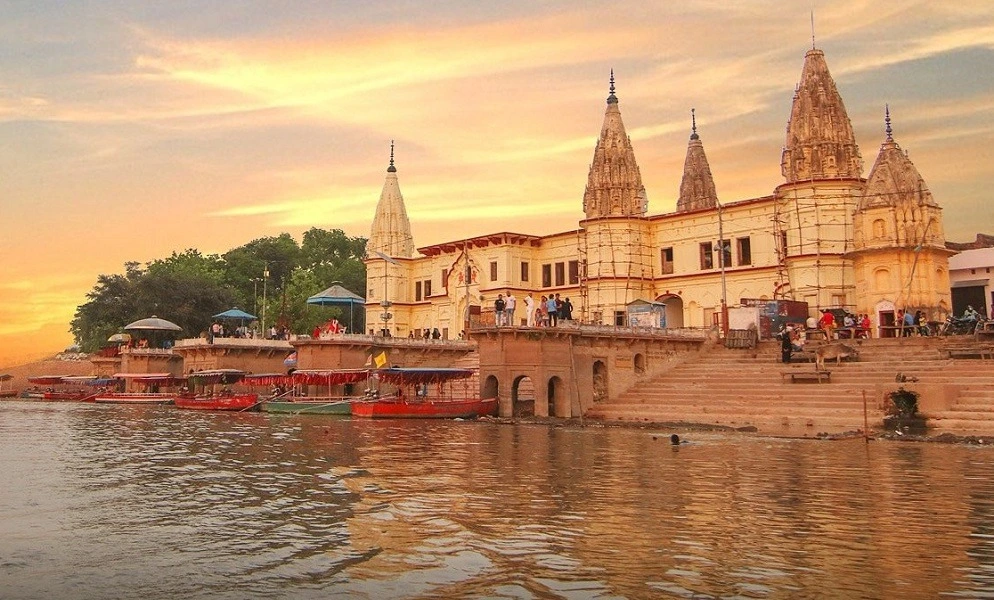Table of Contents
- Introduction to Sarayu and Its Significance
- Ram Mandir: The Heart of Ayodhya
- Hanuman Garhi: A Symbol of Devotion
- Kanak Bhawan: A Testament to Divine Love
- Nageshwarnath Temple: The Keeper of Legends
- Guptar Ghat: The Final Journey
- Experiencing the Sarayu Aarti
- Frequently Asked Questions (FAQ)
1. Introduction to Sarayu and Its Significance
The Sarayu River, flowing gently through the ancient city of Ayodhya, is more than a water body; it’s a symbol of spiritual purity and a witness to history. The riverfront, lined with temples, offers a serene and sacred journey to the heart of Hindu spirituality.
- The Sarayu River is central to Ayodhya’s spiritual landscape.
- Its riverfront is dotted with significant temples and ghats.
2. Ram Mandir: The Heart of Ayodhya
Located on the banks of Sarayu, the Ram Mandir stands as a beacon of Hindu faith. This grand temple, dedicated to Lord Ram, is not just an architectural marvel but also a place of deep spiritual resonance for devotees.
- Ram Mandir, on the Sarayu bank, is a focal point of Hindu worship.
- It combines architectural splendor with spiritual significance.
3. Hanuman Garhi: A Symbol of Devotion
Nestled near the Sarayu River, Hanuman Garhi is a revered temple dedicated to Lord Hanuman. This temple is known for its unique location atop a hill and its role in the spiritual landscape of Ayodhya.
- Hanuman Garhi, close to Sarayu, is dedicated to Lord Hanuman.
- The temple is known for its unique hilltop location.
4. Kanak Bhawan: A Testament to Divine Love
A short distance from the Sarayu lies Kanak Bhawan, a temple dedicated to Lord Ram and Goddess Sita. Known for its exquisite art and architecture, the temple symbolizes divine love and is a popular spot for devotees.
- Kanak Bhawan, near Sarayu, celebrates the union of Lord Ram and Goddess Sita.
- It is renowned for its artistic and architectural beauty.
5. Nageshwarnath Temple: The Keeper of Legends
The Nageshwarnath Temple, standing proudly along the Sarayu, is dedicated to Lord Shiva. According to legend, the temple was established by Kush, son of Lord Ram. It is a testament to the city’s age-old connection with various deities.
- Nageshwarnath Temple, along Sarayu, is dedicated to Lord Shiva.
- It is associated with legends dating back to Kush, son of Lord Ram.
6. Guptar Ghat: The Final Journey
Guptar Ghat, on the banks of the Sarayu, is more than just a ghat; it’s a site of deep spiritual significance. It is believed to be the place where Lord Ram took Jal Samadhi, making it a place of pilgrimage for devotees.
- Guptar Ghat is a significant spiritual site along Sarayu.
- It is believed to be the place of Lord Ram’s Jal Samadhi.
7. Experiencing the Sarayu Aarti
The Sarayu Aarti, held every evening on the banks, is a spiritual spectacle. This ritual, involving the waving of lamps and chanting, creates a mesmerizing aura, offering a divine experience to participants and onlookers.
- Sarayu Aarti is a daily spiritual event on the riverbanks.
- It involves lamp waving and chanting, creating a divine atmosphere.
8. Frequently Asked Questions (FAQ)
- What is the best time to visit the temples along Sarayu?
- Early morning or during the evening Aarti is ideal for visiting.
- Is there a particular order to visit these temples?
- While there’s no set order, starting from Ram Mandir and moving along the river can be a logical route.
- Are there any boat rides available on Sarayu?
- Yes, boat rides are available, offering a unique perspective of the ghats and temples.
- What should I wear during my temple visits along Sarayu?
- Modest, traditional attire is recommended out of respect for the religious sites.
- Can I participate in the Sarayu Aarti?
- Yes, visitors are welcome to participate in the Aarti, which is a profound cultural and spiritual experience.
- Are guides available for temple tours along Sarayu?
- Yes, knowledgeable guides are available and can provide valuable insights into the history and significance of each temple.
- Is photography allowed in and around the temples?
- Photography rules vary by temple; it’s advisable to check with temple authorities or local guides.
- Are there food and accommodation facilities near the temples?
- The area around Sarayu offers various accommodation options and eateries, catering to different budgets and preferences.
A journey along the Sarayu in Ayodhya is not just a pilgrimage but a walk through the pages of history, spirituality, and mythological lore. The temples along this sacred river, each with its unique story and divine presence, offer a profound experience of peace and devotion. For more detailed information, including travel tips, temple schedules, and cultural etiquette, please visit our dedicated section on Ayodhya’s Sarayu riverfront temples on our website.




